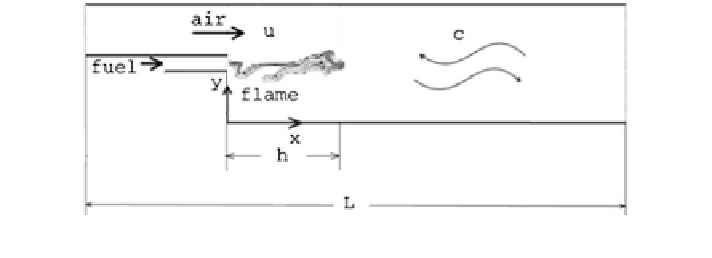Environmental Engineering Reference
In-Depth Information
and combustion by churning out large-scale vortical structures is presented. These
events eventually result in intermittent combustion and drive the combustor to an
unstable mode of operation.
2 Mathematical Formulation
The schematic of the problem with speci
c context to a dump combustor is shown in
Fig.
1
. The
field is modelled in a shorter length scale h and longer
(convective) time scale t = h/u, whereas the acoustics is modelled in a longer length
scale L (for longitudinal acoustic modes) and shorter time scale
fl
flow/combustion
= L/c. h is char-
acteristic of the lateral dimensions of the combustor, such as the step height, and L is
the length of the combustor. u and c are reference
τ
fl
ow and sound speeds. The
fl
fluid is
considered to be a calorically perfect gas and all the diffusion coef
cients are
assumed equal and constant. The conservation equations are non-dimensionalised
with shorter length and time scales, h and
τ
, respectively (Chakravarthy et al.
2007
).
Apart from other non-dimensional quantities, the resulting set of equations have
M = u/c and h/L, the Mach number and the ratio of length scales, respectively. Taken
together, these constitute the simultaneous multiple length and time scales. Both of
these quantities are taken to be unequally small in general, here. To handle two small
parameters simultaneously, each of them is, in turn, represented as a function of a
single small number
ʵ
n
. Here, we choose
m = 1, and let n evolve in the solution as a marker of the compactness of
ʵ
m
and h/L =
ʵ
through the relations M =
fl
ame due to
its coupling with the acoustics.
Any dependent variable
is expanded according to the ansatz . For m = 1, this is
the conventional Mach number expansion, with M as the small parameter. Splitting
the spatial and temporal derivatives for the two scales considered, expanding the
variables as powers of
ˆ
ʵ
and comparing equi-order terms in
ʵ
, we decompose the
conservation equations for the
flow and acoustics in their respective length and time
scales. In the resulting set of equations, it is observed that both the
fl
fl
ow and
acoustics affect the
fl
fluid velocity to leading order. Temporally averaging the base-
fl
flow equations and spatially averaging the acoustic equations results in the
Fig. 1 Schematic of the backward facing step combustor

Search WWH ::

Custom Search